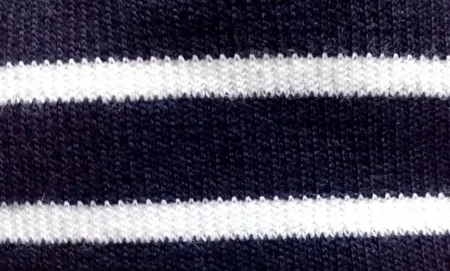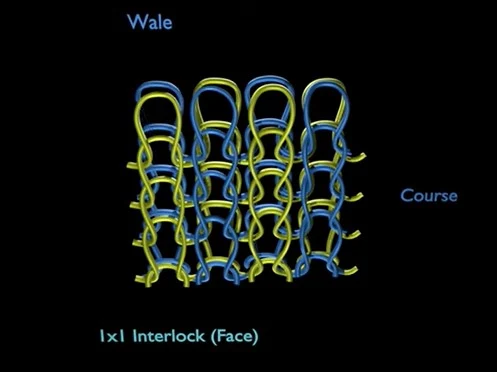Interlock fabric
Interlock fabric, also known as double knit or interlocking knit, is a versatile textile that has gained popularity in the world of fashion and apparel. It is characterized by its unique construction, which involves two layers of knitted fabric interconnected through a series of loops. This interlocking design creates a stable and durable material that offers numerous benefits in terms of comfort, stretchability, and aesthetic appeal.
There are various types of interlock fabrics that cater to different needs and preferences. Whether it's the natural breathability of cotton interlock, the high performance of polyester or nylon/spandex blends for active wearers, the sustainable qualities of bamboo rayon-based interlocks, or the luxurious feel of modal fabrics – there is a perfect option available for every project or style preference.
Now that we have delved into some popular examples of interlock fabric types; it becomes apparent that each variant possesses unique characteristics that influence its application across various industries. Understanding these distinctions enables designers and consumers alike to make informed choices when selecting materials best suited to their specific requirements.
So whether it's for comfortable everyday wear, functional sportswear apparel, environmentally conscious clothing options—or even exquisite luxury garments—interlock fabric stands as a reliable choice with endless possibilities.
Interlock fabric types
Interlock fabric is a versatile and popular textile used in various industries, including fashion, sports apparel, and home furnishings. It is known for its unique construction that provides durability, comfort, and excellent stretchability. There are different types of interlock fabrics which are described below-
a. Cotton interlock fabric
One common type of interlock fabric is cotton interlock. Made from 100% cotton fibers, it offers a soft and breathable texture perfect for everyday wear. Cotton interlock has excellent moisture absorption properties, allowing air circulation to keep the wearer comfortable. Additionally, it has good strength and washability qualities that make it suitable for casual clothing items such as t-shirts, dresses, baby clothes, and undergarments.
b. Polyester interlock fabric
Another variation of interlock fabric is polyester interlock. This type of fabric is made from synthetic fibers derived from petroleum sources. Polyester interlock possesses several desirable features such as high resilience and resistance to stretching or shrinking after washing. It also dries quickly due to its low water absorbency rate, making it ideal for sportswear like leggings or athletic tops where moisture-wicking properties are crucial.
c. Nylon/spandex blend interlock fabric
A third variant worth mentioning is nylon/spandex blend interlock fabric. Combining the strength of nylon with the elasticity of spandex creates a durable yet flexible material commonly used in swimwear or activewear garments requiring both support and stretchability. Nylon/spandex blend interlocks offer exceptional shape retention even after repeated use while providing adequate compression without sacrificing comfort.
d. Bamboo rayon-based interlock fabric
Moreover, bamboo rayon-based interlocks have gained popularity in recent years due to their eco-friendly nature. Bamboo plants require less water compared to other crops used in textile production; thus producing bamboo rayon requires fewer resources overall. This type of fabric exhibits excellent breathability along with natural antibacterial properties that inhibit odor-causing bacteria growth—making bamboo rayon suitable for intimate apparel like underwear or sleepwear.
e. Modal interlock fabric
Lastly but not least, modal interlock fabric is a luxurious type of interlock made from beech tree cellulose. Modal fibers are known for their exceptional softness and silk-like texture, making them favored in high-end fashion garments like dresses or tops. Modal interlocks offer excellent drape, color retention, and moisture absorption properties, ensuring comfort and elegance.
Advantages of interlock fabric
i. One key advantage of interlock fabric lies in its composition. Typically made from 100% cotton or various synthetic fibers such as polyester or nylon, it combines the best qualities of both woven and knitted fabrics. The interlocked structure ensures that it does not easily fray or unravel like some other knitted textiles while maintaining the softness and flexibility often associated with them.
ii. Comfort is another notable characteristic offered by interlock fabric. Due to its dual-layered construction, it tends to be thicker than single-knit fabrics but still maintains breathability. This makes it ideal for garments worn close to the skin, such as t-shirts, underwear, sleepwear, and activewear. Interlock fabric provides warmth without sacrificing air circulation or causing excessive sweating, ensuring maximum comfort throughout various activities.
iii. Furthermore, thanks to its inherent stretchability properties derived from the knitting process itself – where yarns are looped together – interlock fabric offers excellent shape retention and freedom of movement. As a result, garments made from interlock can accommodate different body shapes while providing optimal fit and ease during wear. This versatility is particularly valued in sportswear applications since athletes require unrestricted mobility for peak performance.
iv. The visual appeal of interlock fabric adds yet another dimension to its desirability within the fashion industry. The two layers create a smooth surface on both sides without any visible stitching lines common in other types of knit fabrics like jersey knits or ribbed knits. As a result, clothing made from interlock appears clean-cut with a refined finish that exudes a sense of quality and elegance. This makes it suitable for a wide range of applications, from casual everyday wear to more formal attire.
v. Due to its versatile nature, interlock fabric has found widespread use across various industries. Apart from clothing, it is also employed in the production of home textiles such as bedsheets, pillowcases, and towels. Its durability ensures that these items withstand frequent washing and regular use without losing their shape or softness.
vi. While interlock fabric offers numerous advantages, care must be taken during its production to ensure high-quality results. Proper yarn selection, knitting techniques, and finishing processes are essential in achieving the desired characteristics of the fabric. Additionally, customers should follow specific care instructions provided by manufacturers to maintain the integrity and longevity of garments made from interlock fabric.
Conclusion
Interlock fabric's unique construction provides a combination of comfortability, stretchability, durability, and aesthetic appeal that sets it apart from other textile options. With its versatility spanning across fashion and home industries alike – offering both functionality and style – it is no wonder that interlock fabric continues to be favored by designers and consumers around the world.









0 Comments